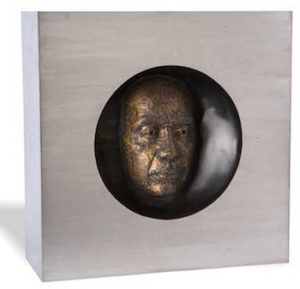
Ralph Ellison by Ed Wilson
*This date marks the birth of Ed Wilson in 1925. A Black sculptor artist, he was known for figurative works typically created in metal.
Born in Baltimore, Maryland, Wilson became interested in art as a child while recovering from rheumatic fever. After serving in the United States Army from 1943 to 1946, he studied painting at the University of Iowa but eventually switched his focus to sculpture. After earning his M.A. from the University of Iowa in 1953, Wilson taught at North Carolina College (now North Carolina Central College) in Durham.
He met American sculptor William Zorach, who became a lifelong friend and artistic influence there. While in Durham, Wilson was deeply involved in the civil rights movement. The movement's influence is apparent in his subsequent works, including Minority Man (1957, State University of New York, Binghamton), carved in red hickory wood, which depicts the elongated torso of a male figure, head turned upward and hands clasped at his chest. It is intended to satirize a begging attitude, which, Wilson felt, many people associate with minority groups.
In 1964, Wilson accepted an invitation to develop a studio art program at Harpur College of the State University of New York at Binghamton. He soon became chairman of the college’s art and art history department. An exhibition of Wilson’s work at Harpur College helped win him a commission to design a park in downtown Binghamton honoring President John F. Kennedy. A three-sided column rises at the center of the triangular JFK Memorial Park, completed in 1969. Bronze relief panels on the sides of the column, entitled The Seven Seals of Silence, depict how people refuse to participate or take an active interest in solving the problems of our time.
For example, a panel called The Conformists portrays those who unquestioningly accept prevailing attitudes. The JFK Memorial Park won critical praise for departing from the traditional memorial sculpture. Wilson’s Second Genesis (1969-1971) is displayed at Lake Clifton High School, Baltimore, Maryland. It is a work in multiple pieces, featuring eight large aluminum blocks that display impressions of full-sized, robot-like human figures. This work offers a commentary on the consequences of an increasingly mechanized society.
Wilson’s stainless steel and bronze Portrait of Ralph Ellison (1974-1975, Ralph Ellison Library, Oklahoma) commemorates the author of The Invisible Man (1952), who inspired Wilson during the civil rights movement. Ed Wilson died in 1996.
The St. James Guide to Black Artist
Edited by Thomas Riggs
Copyright 1997, St. James Press, Detroit, MI
ISBN 1-55862-220-9